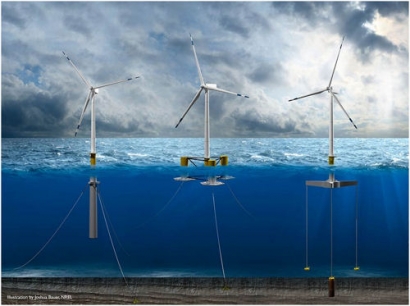
NREL researchers have outlined a new vision for lowering the cost of floating wind plants. Classic floating platform concepts that include spar (left), semisubmersible (center), and tension leg platforms (right) need to be optimized to achieve cost competitiveness
A recent study by the U.S. Department of Energy’s National Renewable Energy Laboratory unveils a new strategic vision for floating offshore wind. Researchers identify barriers that must be overcome to bring down the overall cost of energy produced, then outline a vision for an integrated systems approach with the potential to significantly improve the market feasibility of floating wind plants.
“While we’ve made great progress with innovations related to individual components and tools, only a comprehensive systems-based approach can allow floating wind technology to fully mature in commercial markets,” said NREL Offshore Wind Platform Lead and study co-author Walt Musial. “A multidisciplinary effort makes it possible to simultaneously focus on a wide range of factors and then optimize designs to achieve a minimum system cost.”
Much of the 2,000 GWs of U.S. offshore wind domestic electricity-generating capacity is found near coastal population centers. More than 58% of this resource is located in water depths of 60 meters or greater, where the engineering challenges of fixed-bottom installations directly connected to the sea floor make them technically and/or economically infeasible. Floating platforms are needed to most effectively harness wind energy in these locations.
Detailed modeling by NREL researchers shows that needed cost reductions are unlikely to come from a single breakthrough invention, but will require the deliberate combination of design building blocks that span multiple disciplines—a complementary combination of innovations in technologies, design features, and installation and operational strategies.
To achieve this vision, the NREL approach uses a fully integrated systems-engineering and techno-economic design to capture the complex interactions among physics, manufacturing, installation, and operation of floating wind systems and identify optimal designs that dramatically reduce costs.
The current approach to offshore wind system design is iterative, with each company bringing to the table its own area of expertise and profit motive.
The NREL study examines the current state of floating offshore wind technology and highlights gaps in development and areas that could benefit from additional tools and innovation. Researchers looked at system components including turbines, platforms, moorings, and controls. They also reviewed plant-level factors, such as wake and array effects; manufacturing, installation, operation, and maintenance; grid integration; and environmental impact.
The study itemizes important experience-based engineering and operational considerations and describes the advantages of factoring them into design decisions to narrow the options for cost-effective designs. For instance, structures that can be towed to deep water locations for deployment and to shore for maintenance offer both logistic and economic benefits to operators. Designs that use this know-how and can be standardized for use in a wide range of ocean environments and ports promise greater economies of scale for manufacturers and more widespread adoption by industry.
Researchers also perceive that existing engineering-focused tools do not adequately factor in cost and systems design considerations, while systems engineering tools lack sufficient fidelity of the physics to capture all critical design drivers. To bridge this gap, DOE’s Advanced Research Projects Agency-Energy recently initiated a new program, Aerodynamic Turbines Lighter and Afloat with Nautical Technologies and Integrated Servo-control , to revolutionize floating offshore wind turbine design and design tools. NREL and its ATLANTIS collaborators from the University of Illinois Urbana-Champaign and Colorado State University are pursuing the vision put forth in the paper by creating the open source Wind Energy with Integrated Servo-control (WEIS) toolset to optimize floating offshore wind turbines.
Once system optimization tools are developed, they can be used to quantify the cost-benefit trade-offs of individual technologies and different system or industrial strategies. Researchers envision the study eventually feeding into a research program that includes optimization of whole systems—including entire wind plants and their supporting logistics—as well as trade-off and sensitivity studies related to substructure, anchoring, turbine, rotor, generator, controls, and materials innovations.
NREL’s proposed integrated systems design approach aims to help industry deploy cost-effective floating turbine systems by 2030.

